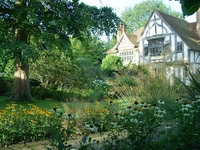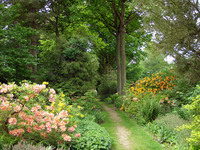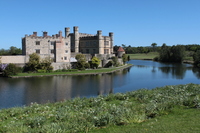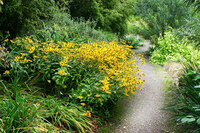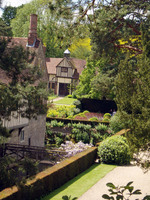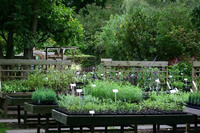- England
- Scotland
- France
- Holland
- Germany
- Italy
- Spain
- Portugal
- USA
- China
- Japan
- India
- Iran
- Advice
- Gardens
- England
- Scotland
- France
- Holland
- Germany
- Italy
- Spain
- Portugal
- USA
- China
- Japan
- India
- Iran
- Advice
- Garden Tours
The house takes its name from the Restoration of Charles II, because he stayed here on his return from exile in 1660. But it almost deserves the name on account of the high quality of the garden 'restoration'. The word has to appear in quotation marks for several reasons (1) because no details of the old garden were available (2) because a number of old fragments and ornaments were incorporated in the design, giving it a pleasingly 'authentic' character (3) because it is a typical exercise in garden restoration: a little bit of everything which it might possibly have had at some point in history. One can be sure that it never looked as it does today at any previous point in history, but this does not detract from the pleasure of visiting the garden. The 'restoration' was done after 1994 and includes an orchard, a vegetable plot, a mount, a parterre (using a pattern from the house doors) and a pool, based on the shape of a Queen Anne mirror, which runs through some authentic-looking gothic arches in re-used red brick. The design is a great success, despite this pastiche approach. They should have forgotten about Charles II and gone all-out on the re-creation of a Yorkist or Tudor garden. The dates for the first phases of building the house are 1454 and 1502-22.
Samuel Pepys visited Restoration House on 30th June 1667 and wrote in his diary of entering '...the cherry garden, and here met with a young, plain, silly shopkeeper and his wife, a pretty young woman, and I did kiss her..'. It is puzzling that the garden 'restorers' did not re-create the cherry garden - and it is a great pity that another famous author did not pen a description of the garden: Restoration House is also famous as Satis House in Charles Dickens' novel Great Expectations - the home of Miss Haversham.
17-19 Crow Lane, Rochester, Kent, England, ME1 1RF
Late May to late September. Thursdays and Fridays. Open 10am to 5pm.
Adult House & Garden £6.50, Garden only £3.00

